A blanket application, aka broadcast application is when you cover a large area with a uniform amount of herbicide, fungicide, or insecticide.
Table of Contents- Sprayer
- Step 1: Making a Property Map
- Step 2: Calibrating Your Sprayer
- Step 3: Understanding the Label
- Step 4: Doing the Blanket Application
Sprayer
You apply liquid herbicides, fungicides, or insecticides with a sprayer. These can either be handheld, which hold between 1-2 gallons of final solution, or a backpack style that holds up to 4 gallons of final solution. Backpack sprayers are a good solution for blanket applications because you’ll be covering a large area with a lot of liquid.
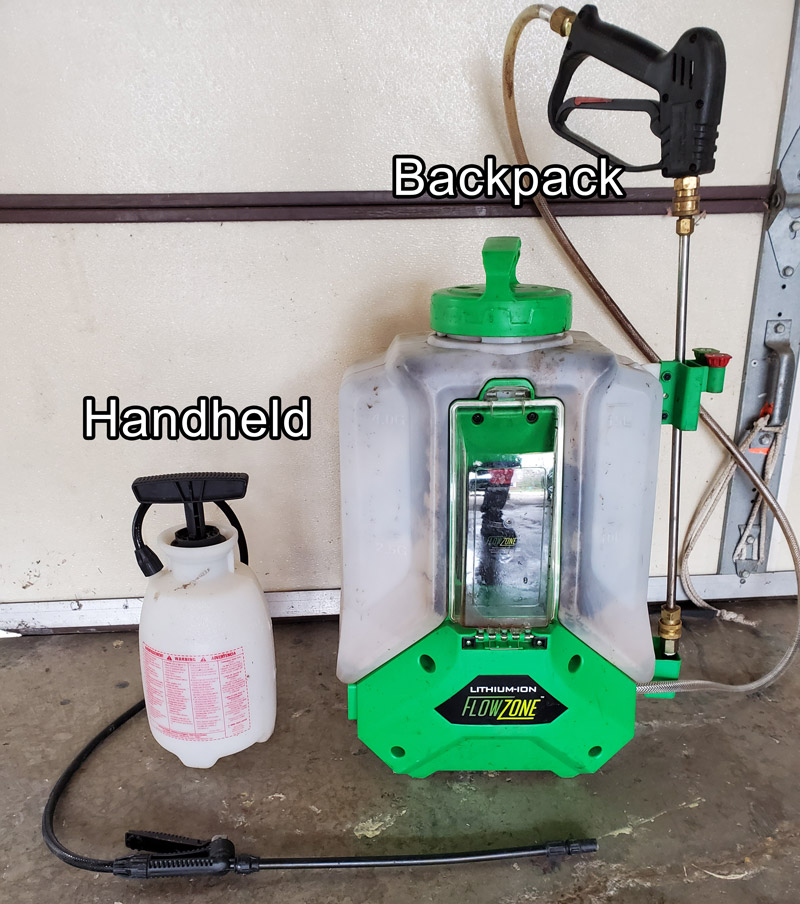
Homeowner
DIYer / Professional
Less refills
Lawn Dork™
Consistent pressure and flow
Step 1: Making a Property Map
Before you decide to do a blanket application, please be sure to make a property map here. Once you’ve done that, you won’t have to do it again… unless you annex your neighbor’s lawn. You should end up with something like this:
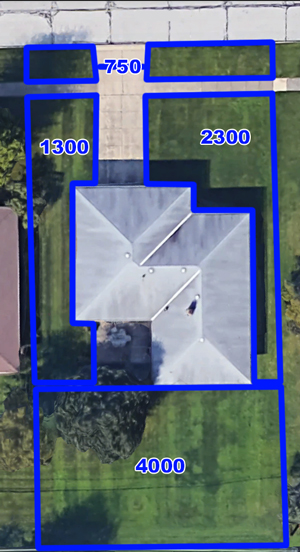
That way, you know the size of your property in order to measure how much product to use on it.
Step 2: Calibrating Your Sprayer
Before doing your first blanket application, it’s important to calibrate your sprayer.
At first it may seem confusing, but trust me, it becomes a feel thing. You need to get to understand your sprayer, so you must practice with water first. Be one with the sprayer.
For blanket applications, it’s recommended to use a fan tip nozzle. This type of nozzle sprays the liquid in an even line, so when you’re walking… you’re getting even coverage.
- Fill your backpack sprayer with just water up to the highest mark (your sprayer has measurement marks)
- Mark out 1,000 square feet of area. You can use sticks, rocks, or lawn gnomes to mark each corner of your 1,000 square foot rectangle. For reference, some options for a 1,000 square foot rectangle are: 40’ x 25’ or 50’ x 20’ or 31’ 7.5” x 31’ 7.5” for a perfect square.
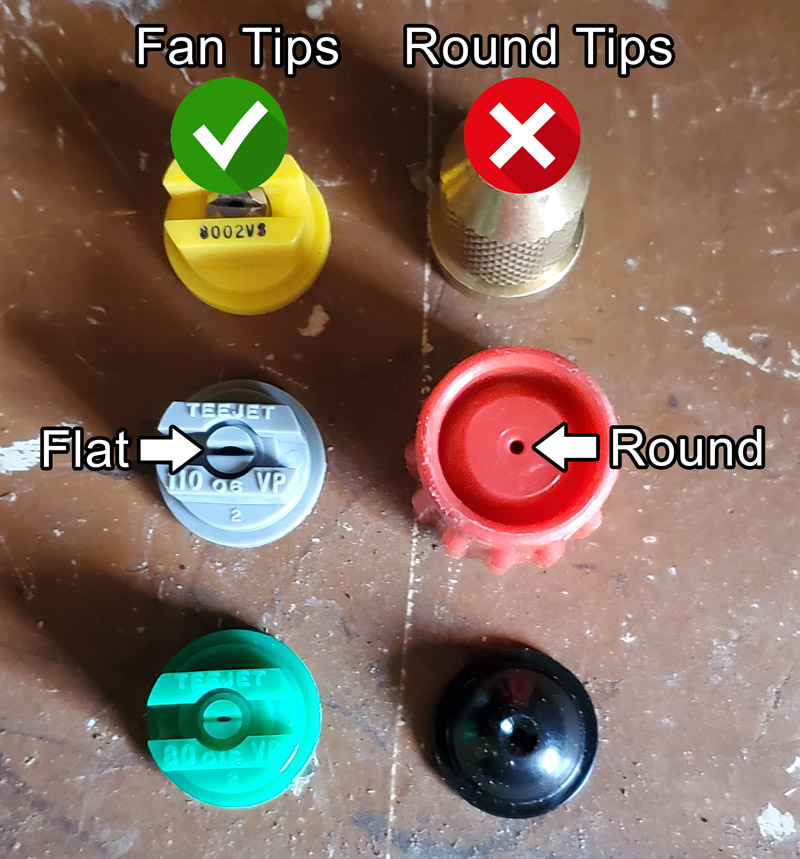
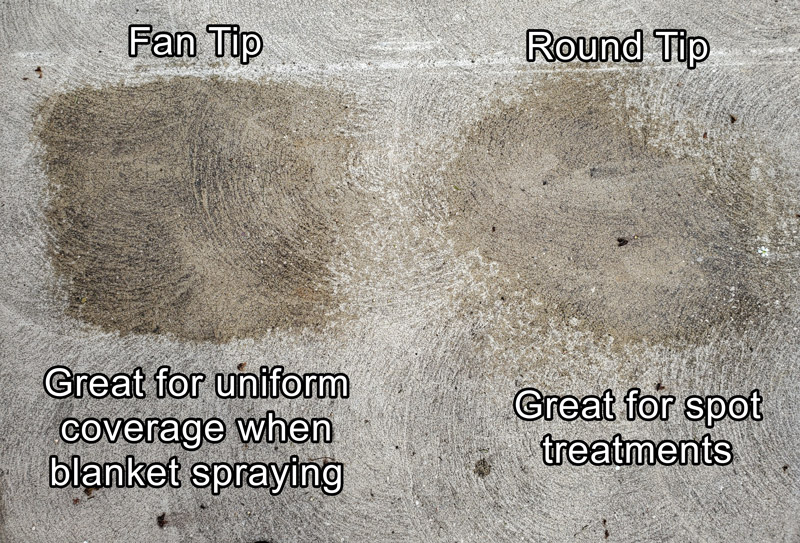
Okay, so you’ve got your sprayer filled with water and you’re ready to calibrate. Be sure to clean the sprayer out well if you've used it with chemicals before.
- If you’re using a pump sprayer, make sure it is pumped up to maximum pressure at all times. This will ensure that you are spraying at a consistent flow. Additionally, battery powered sprayers are available that always spray at a consistent PSI.
-
Spray the entire 1,000 square foot area as such and walk at a pace that you can remember. This can be your normal pace, fast walking pace, or whatever… it’s just crucial that after you do this calibration… you can train yourself to walk at the same consistent pace. It sounds difficult, but it’s pretty easy after you do it a couple of times.
 The dark green is the area sprayed.
The dark green is the area sprayed.
-
Once you evenly cover the 1,000 square foot area, figure out how much liquid you used.
- I.e. If you filled your sprayer to 4 gallons, and you have 3.5 gallons left… then you use 0.5 gallons per 1,000 square feet. If you used 1.5 gallons out of 4 gallons, then you use 1.5 gallons per 1,000 square feet. Every sprayer is different.
Write this rate down so you have it for later.
Step 3: Understanding the Label
The rate at which you apply the product is either listed on the label or on the herbicide’s page on this website.
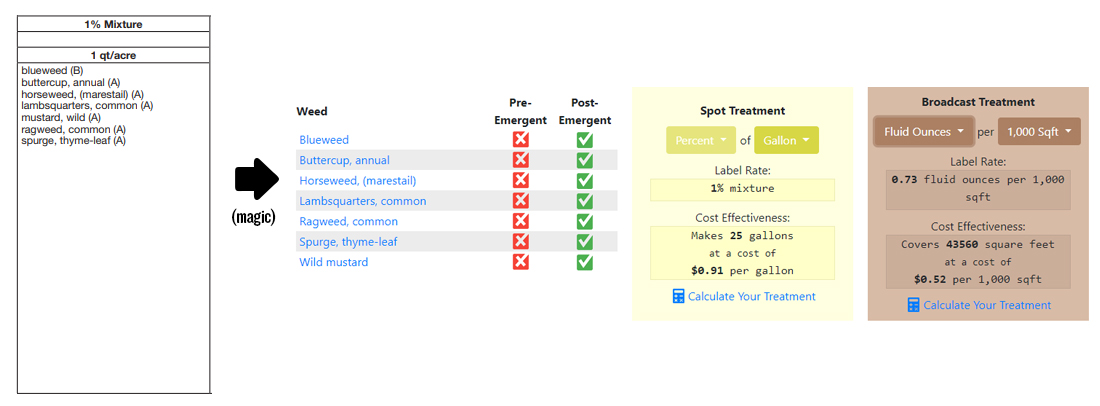
The broadcast rate always shows the amount of product per area, not the amount of your final mixture which includes water.
For example: The label rate states: 0.73 fluid ounces of product per 1,000 square feet. Now, you may say: “Lawn Dork… there’s no way I can evenly spray such a small amount of liquid over such a large area!” And I’ll reply with, “Shut up, of course you can. You mix up the 2 fluid ounces of product into water... giving you a larger amount of final product with a greater margin of error.”
- You can mix 0.73 fluid ounces of herbicide into one gallon of water, but you must make sure you use the entire 1 gallon on the 1,000 square foot area.
- You can mix 0.73 fluid ounces of herbicide into 0.73 gallons of water, but you still must make sure you use the entire 0.73 gallons over the 1,000 square foot area.
- You can mix 1.46 fluid ounces of herbicide into 1 gallon of water, so that will cover a 2,000square foot area (two times the label rate of 0.73 fluid ounces per 1,000 square feet). You must then spray your 1 gallon over the entire 2,000 square feet because there is 0.73 fluid ounces in each half gallon.
- You get the gist… whatever works best for your sprayer.
Step 4: Doing the Blanket Application
Now that you’ve figured out how much your sprayer will spray per 1,000 square feet and the square footage of your property zones, you can move on to doing a real application.
Using everything we’ve learned, let’s follow an example.
- Label rate says 2 fluid ounces of product per 1,000 square feet.
- The area you need to cover is 4,000 square feet.
- Your sprayer sprays at 0.5 gallons per 1,000 square feet.
Okay, so first we figure out how much product we need to put on the total of 4,000 square feet.
(2 fluid ounces) * (4,000 / 1,000)
= 2 fluid ounces * 4
= 8 fluid ounces of product over 4,000 square feet
Next we figure out how much water we need to mix that into based on our sprayer calibration.
(0.5 gallons) * (4,000 / 1,000)
= 0.5 gallons * 4
= 2 gallons of water
Therefore, you need to mix 8 fluid ounces of product into 2 gallons of water. You then will spray that 2 gallons of product evenly over your 4,000 square foot area using the walking pace you practiced when calibrating.

That's the hard way to do the math. You can use my Liquid Blanket Application Calculator if you want the easy route. I'll include it here for your convenience:
| # of Units | Cost Per Unit | Units Needed | Application Cost |
|---|---|---|---|
Not bad, right? If you are doing a post-emergent application, please be sure to include a surfactant when spraying. Surfactant’s are usually used at 2x the amount of herbicide product you use. In this case, it would be 16 fluid ounces of surfactant + 8 fluid ounces of herbicide into 2 gallons of water. Read about surfactant here.
There’s plenty of resources on this site, including calculators for your specific herbicides and generic calculators. Feel free to favorite this page and come back to it, if you need a refresher or want to use the calculators again.

How safe is Celsius WG 6666194 to use around pets?
Report